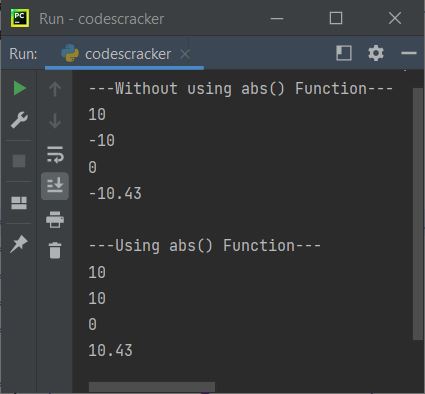- Python Built-in Functions
- Python All Built-in Functions
- Python print() Function
- Python input() Function
- Python int() Function
- Python float() Function
- Python len() Function
- Python range() Function
- Python str() Function
- Python ord() Function
- Python chr() Function
- Python ascii() Function
- Python pow() Function
- Python type() Function
- Python List Functions
- Python list() Function
- Python insert() Function
- Python append() Function
- Python extend() Function
- Python pop() Function
- Python remove() Function
- Python reverse() Function
- Python sort() Function
- Python sorted() Function
- Python Dictionary Functions
- Python dict() Function
- Python update() Function
- Python get() Function
- Python keys() Function
- Python setdefault() Function
- Python fromkeys() Function
- Python items() Function
- Python popitem() Function
- Python Tuple Function
- Python tuple() Function
- Python Set Functions
- Python set() Function
- Python frozenset() Function
- Python String Functions
- Python split() Function
- Python join() Function
- Python format() Function
- Python replace() Function
- Python Iterator Functions
- Python iter() Function
- Python min() Function
- Python max() Function
- Python sum() Function
- Python count() Function
- Python index() Function
- Python copy() Function
- Python clear() Function
- Python next() Function
- Python filter() Function
- Python enumerate() Function
- Python zip() Function
- Python reversed() Function
- Python Number Functions
- Python abs() Function
- Python bin() Function
- Python oct() Function
- Python hex() Function
- Python round() Function
- Python divmod() Function
- Python complex() Function
- Python File Handling Functions
- Python open() Function
- Python read() Function
- Python readable() Function
- Python readline() Function
- Python readlines() Function
- Python write() Function
- Python writable() Function
- Python writelines() Function
- Python close() Function
- Python seek() Function
- Python tell() Function
- Python flush() Function
- Python fileno() Function
- Python truncate() Function
- Python Class Functions
- Python object() Function
- Python property() Function
- Python getattr() Function
- Python setattr() Function
- Python hasattr() Function
- Python delattr() Function
- Python classmethod() Function
- Python staticmethod() Function
- Python issubclass() Function
- Python super() Function
- Python Misc Functions
- Python all() Function
- Python any() Function
- Python isatty() Function
- Python bool() Function
- Python callable() Function
- Python globals() Function
- Python locals() Function
- Python dir() Function
- Python id() Function
- Python isinstance() Function
- Python map() Function
- Python repr() Function
- Python slice() Function
- Python vars() Function
- Python Advance Functions
- Python help() Function
- Python hash() Function
- Python breakpoint() Function
- Python bytes() Function
- Python bytearray() Function
- Python memoryview() Function
- Python compile() Function
- Python eval() Function
- Python exec() Function
- Python Tutorial
- Python Tutorial
- Python Examples
- Python Examples
Python abs() Function
To find an absolute value of a number in Python programming, we need to use abs(). That is, the function abs() returns the absolute value of a number passed as its parameter.
Now the question is, what is an absolute number ?
The answer is, an absolute value is basically a modulus of a real number. Modulus in the sense, means a non-negative value.
Python abs() Function Example
The program given below uses abs() function, that returns an absolute value.
a = -10 print(abs(a))
Here is the sample output produced by above program:

As you can see from the above program, the abs() function returns a non-negative equivalent of a value passed as its argument. Let's create another program:
a = 10 b = -10 c = 0 d = -10.43 print("---Without using abs() Function---") print(a) print(b) print(c) print(d) print("\n---Using abs() Function---") print(abs(a)) print(abs(b)) print(abs(c)) print(abs(d))
This time, the output produced by above program is:

Key Notes on abs() Function in Python
Important - The abs() returns non-negative value, if argument passed or given is a real number.
Important - The abs() returns the magnitude part, if argument given is a complex number.
Now the question is, what is magnitude part of a complex number ?
The answer is, the magnitude part of a complex number, is the distance, the point is from origin of the complex plane.
It is denoted by |a + bi|, is calculated by using the formula,
|a + bi| = √a2 + b2. For example, the magnitude part of complex number
3 - 4j is equal to:
√32 + 42 = √9 + 16 = √ 25 = 5
The example given below, shows the use of abs() function in complex number, or to find the magnitude part of a complex number.
abs() Function for Complex Number
Here is an example, uses abs() in Python uses complex number:
complex_number = (3-4j) print(abs(complex_number))
produces 5.0 on output screen.
« Previous Function Next Function »